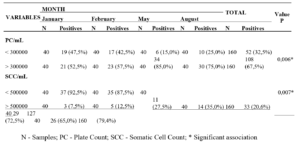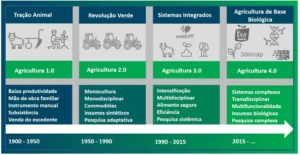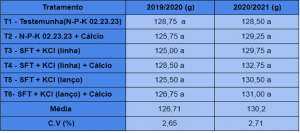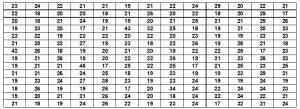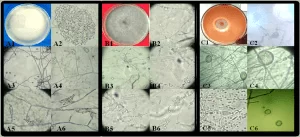ORIGINAL ARTICLE
SOARES, Karla Danielle Almeida [1], ALVES, Elizabeth Simões do Amaral [2], SILVA, João Manoel da [3], VIANA, Cibeli [4], ANDRADE, Andrezza Cavalcanti de [5], ALVES, Aglair Cardoso [6], SILVA, Maria Goretti Varejão da [7], SILVA, Daniel Dias da [8], MOURA, Vilton Edson Figueiroa de [9], SILVEIRA, Ana Virgínia Marinho [10], SOARES, Anísio Francisco [11], MEDEIROS, Elizabeth Sampaio de [12]
SOARES, Karla Danielle Almeida et al. Microbiological quality of raw milk: community expansion tanks in Alagoas. Revista Científica Multidisciplinar Núcleo do Conhecimento. Volume 09, Issue 02, Volume 02, pp. 05-17. February 2024. ISSN: 2448-0959, Access link: https://www.nucleodoconhecimento.com.br/agronomy-en/microbiological-quality, DOI: 10.32749/nucleodoconhecimento.com.br/agronomy-en/microbiological-quality
ABSTRACT
Milk is a highly nutritious food consumed by a large part of the population, and due to its nutritional composition, its quality can be altered by the amount of microorganisms present. The objective of this study was to evaluate the microbiological quality of raw milk from community expansion tanks in the state of Alagoas. A total of 160 milk samples were aseptically collected from the three mesoregions of the state for microbiological analysis. It was observed that 10.83% (13/120) of the samples had Staphylococcus coagulase-positive counts lower than 105 CFU/mL, and 10.83% (13/120) had counts higher than 105 CFU/mL. For coliforms, 18.8% (30/160) were found to have counts less than 1.1×103 MPN/mL, while 81.2% (130/160) of the samples had values higher than 1.1×103 MPN/mL. No Salmonella spp. or Listeria spp. were found in any of the samples. Aeromonas spp. was found in 28.7% (46/160) of the samples. For mesophilic microorganisms, 15% (24/160) of the samples were within the standard required by legislation, while 85% (136/160) were outside the established limit of up to 6×105 CFU/mL. Psychrotrophic microorganism counts were higher than 5×106 CFU/mL in 41.9% (67/160) of the samples analyzed. It was concluded from this study that the high microorganism counts in the analyzed milk and the inadequate temperature of the tanks at the time of collection can lead to the production of a low-quality product due to the deteriorative or pathogenic action of the microorganism. Therefore, the implementation of good practices during milking, transportation, and storage of refrigerated raw milk is suggested to prevent contamination of the raw material, ensuring a product with certified quality.
Keywords: Food Microbiology, Animal Production, Food Safety.
1. INTRODUCTION
Over the past decade, there has been significant growth in Brazil’s dairy cattle farming, a result related to improvements in productive development, allowing the country to be classified as one of the main players in the dairy industry, reaching the mark of 33.8 billion liters/year. Brazil achieved the reputation of being the third largest milk producer in the world during 2018 (Embrapa Gado de Leite, 2020).
Given this potential for dairy farming and the high growth in production, it is extremely important that quality keeps pace with productive development. Ensuring quality in the raw material promotes higher yields of processed products in the industry and also reduces the risks inherent in the food safety of milk that does not comply with the standards required by legislation (Guimarães et al., 2020).
Therefore, quality control of milk should be elucidated according to microbiological analyses in raw milk. High counts of mesophilic and psychrotrophic microorganisms, which have pathogenic and deteriorating actions respectively, represent a limitation for processing, as well as a risk to public health (Maciel; Birkheuer; Rempel, 2018).
It is worth noting that the quality of milk produced in Brazil is outside the established microbiological standards (Hervert; Alles; Martin, 2020), and high counts of pathogenic microorganisms do not guarantee food safety, such as Staphylococcus coagulase positive, mesophile commonly associated with foodborne illness outbreaks (Oliveira; Oliveira; Moraes, 2020); Enterobacteriaceae, which reduce shelf life and cause various diseases of public health interest such as Salmonellosis (Schu and Zat, 2023); Aeromonas sp., which multiply under refrigeration in milk and are strong biofilm formers (Canellas and Laport, 2022); Listeria monocytogenes, which has pathogenic potential and is transmitted through raw refrigerated milk causing Listeriosis in humans (Silva; Lopes; Bastos, 2022).
Therefore, to improve the microbiological quality of raw milk, the publication of Normative Instruction No. 76 (Brazil, 2018) establishes minimum requirements for producers to comply with regarding production, identity, and quality of milk. It is extremely important to monitor contaminating microorganisms in milk, arising from management conditions, hygiene, or linked to animal health (Rosa et al., 2023). This study aimed to evaluate the microbiological quality of raw milk from community expansion tanks in the state of Alagoas.
2. MATERIALS AND METHODS
A total of 160 milk samples were collected from January to August 2013, a period that includes the summer and winter seasons in the Brazilian Northeast. The samples were collected at four different time points (January, February, May, and August) from expansion tanks belonging to a dairy cooperative in the state of Alagoas.
The study was conducted in 23 municipalities across the three mesoregions of the state, which have different physical, economic, social, and cultural characteristics (Agreste Alagoano, Leste Alagoano, and Sertão Alagoano). The Agreste Alagoano region had the highest number of municipalities in the study, and the largest number of samples came from the eastern region of the state.
The milk samples were collected in sterilized bottles of approximately 500 mL, with the expansion tank temperature measured beforehand, and then placed in isothermal boxes. In the laboratory, sample preparation followed the International Organization for Standardization (ISO) 6887-2 protocol. The initial suspension and its dilutions were prepared, with 25 mL of milk taken aseptically from each sample and added to 225 mL of buffered peptone water (BPW). The mixture was homogenized using a Stomacher homogenizer for two minutes to obtain the initial suspension (10^-1 dilution), followed by successive dilutions (10^-2, 10^-3, 10^-4, 10^-5), totaling 120 samples for microbiological analysis. The methodology of ISO 688-2, ISO 6579, and ISO 11290-1 was followed for the analysis of Staphylococcus coagulase positive, Salmonella spp., and Listeria spp., respectively (ISO, 2002; ISO, 2003).
For coliform count analysis, the Most Probable Number (MPN.g-1) technique recommended by Silva et al. (2001) was used. For Aeromonas spp. research, 100µL of all dilutions were inoculated onto 90x15mm Petri dishes containing “Aeromonas Medium Base” medium, with the inoculum distributed on the surface in duplicate. The plates were then incubated in a bacteriological incubator at 30°C for 24-48 hours, and the presence of characteristic colonies was assessed. Psychrotrophic bacteria count was performed by surface seeding 0.1 mL of the dilutions onto Petri dishes containing Plate Count Agar (PCA) medium in duplicate.
The plates were incubated at 7°C for 7 days, and the colony-forming units were counted. The data obtained were expressed as CFU/mL (Brazil, 2003). For mesophilic bacteria count, 1 mL of each selected dilution was deposited onto plates, and approximately 15 to 20 mL of melted Plate Count Agar (PCA) medium at 46-48°C was added. The agar was homogenized with the inoculum, poured into plates in duplicate, and allowed to solidify, followed by incubation at 36°C for 48 hours.
The calculation of microorganism numbers in the sample analysis was expressed as CFU/mL (Brazil, 2003). Data analysis was conducted using descriptive statistics, and to assess the association between the results of the investigated parameters and the sampling times, univariate analysis was performed using the Chi-square test (Sampaio, 1998). The SPSS for Windows program, version 19.0 – Statistical Package for the Social Science, was used for statistical calculations.
3. RESULTS AND DISCUSSION
It was observed that 78.3% (94/120) of the samples were negative for Coagulase-Positive Staphylococcus (CPS), differing from Martins; Araújo; Ribeiro (2023), who conducted research on Coagulase-positive Staphylococcus and antimicrobial susceptibility isolated from raw milk sold in public places in the municipality of Açailândia-MA, and found the microorganism in 100% of the 120 raw milk samples. According to most producers who send the milk produced to the tanks studied, cases of mastitis in the herds are infrequent, which may explain the high percentage of samples negative for this microorganism.
According to a study by Nascimento et al. (2023), these microorganisms can be present in the teat cup liners, in the milking equipment, and on the hands of milkers, who transmit them to the animals, causing mastitis and affecting the quality of milk through the toxins produced by these microorganisms.
Given that the current Instruction Normative No. 76, from the Ministry of Agriculture, Livestock, and Supply (MAPA), does not establish microbiological standards for Coagulase-Positive Staphylococcus in raw milk, the highest percentage of samples described by these authors was within the limit established by the treaty establishing the European Community, which is regulation (EC) No. 1441/2007, establishing a value of 105 CFU/g for CPS in raw milk. According to this parameter, 10.83% (13/120) of the samples in this study were within this limit, while 10.83% (13/120) had counts higher than 105 CFU/mL, which according to Costa and Dias (2013), values above 105 CFU/mL are considered significant for causing food poisoning by Coagulase-Positive Staphylococcus.
For coliforms, 18.8% (30/160) of the samples had counts below 1.1×103 MPN/mL and 81.2% (130/160) of the samples had values above 1.1×103 MPN/mL, not corroborating with Silva et al. (2010), who analyzed 33 samples of raw milk in the municipality of Umuarama, PR, and found that only 12.12% (4/33) exceeded 1.1×103 MPN/mL.
The high number of coliforms found can be correlated with the poor quality of water used by some producers for cleaning utensils and cooling tanks due to the regions most affected by drought, and it was also observed that the highest rates were found in the least rainy months. Since, according to Silva, Lopes, and Oliveira (2019), the presence of coliforms can come from poor quality water used in the cleaning of equipment, utensils, and milkers’ hands.
In the results found by Freitas, Travassos, and Maciel (2013), who analyzed samples of raw milk produced in the state of Paraíba, they found that 44.44% (4/9) had values above 1.1×103 MPN/mL, reflecting in the obtaining of derivative products outside the standards required by the legislation. As coliforms are i nactivated during pasteurization, their presence in pasteurized milk above the legal limit is an alert that inadequate processing of raw milk or post-processing contamination occurred (Craven; Mcauley; Hannah, 2021).
According to Leira, Botelho, and Santos (2018), from 2012 to 2021, there were 6,347 notifications of foodborne illnesses in Brazil, where the bacteria Escherichia coli and Salmonella spp. (Enterobacteriaceae), and Staphylococcus aureus (Staphylococcaceae) were the main etiological agents involved.
There was an absence of Salmonella spp. and Listeria spp. in all samples tested in this study. However, Yamaguchi et al. (2013) found Salmonella spp. in 1.57% (4/255) of powdered milk samples from food processing companies in Maringá-PR.
It is worth noting that episodes of foodborne outbreaks associated with pasteurized milk are frequent, mainly due to raw milk having a high microorganism count, favoring their greater survival and post-pasteurization contamination (Calahorrano-Moreno; Ordoñez-Bailon; Baquerizo-Crespo, 2022).
Conceição et al. (2023) did not find Listeria spp. or Salmonella spp. in any of the 15 samples of artisanal cheese at fairs in the municipality of São Luiz in Maranhão, corroborating the findings in this study.
Aeromonas spp. was found in 28.7% (46/160) of the samples analyzed, not corroborating with Cereser et al. (2013), who analyzed Aeromonas spp. in 25 samples of raw milk and found Aeromonas spp. in 96% (24/25), and emphasized that raw milk contaminated with Aeromonas spp. is the main spreader in dairy products.
In Brazil, there is no regulation for the microbiological quality of raw milk regarding psychrotrophic microorganisms. According to Cruz et al. (2019), it is considered unfeasible to use milk with psychrotrophic microorganism counts exceeding 5.0 x 106 CFU/mL. Thus, in 41.9% (67/160) of the samples analyzed, counts of these microorganisms were found to be above 5.0 x 106 CFU/mL.
Samples with high counts observed may be related to some tanks holding large quantities of milk for periods exceeding 48 hours due to the difficulty of access by the collection truck in certain locations. Additionally, poor hygiene conditions of some buckets and expansion tanks were also observed.
Instruction Normative No. 76 of 2018 stipulates a temperature for cooling milk in community expansion tanks of up to 7°C; thus, 75% (120/160) of the samples were in compliance with the legislation (Table 1).
Table 1 – Milk cooling temperatures found
| TEMPERATURE | N |
| Below 7°C | 120 |
| Above 7°C | 40 |
| Total | 160 |
Source: Normative Instruction No. 76 of 2018.
It is necessary to report that during the research, the region of Sertão Alagoano experienced a significant power outage at the time of sample collection. This event interferes with the maintenance of the refrigeration temperature of the community expansion tanks and justifies the non-compliance observed in some raw milk samples.
In May, the highest temperatures were observed, which favors the growth of mesophilic microorganisms and coliforms at 45°C, of which high counts were found in the study (Table 2).
Table 2 – Results of the parameters analyzed in milk samples from expansion tanks from properties in the state of Alagoas, 2013
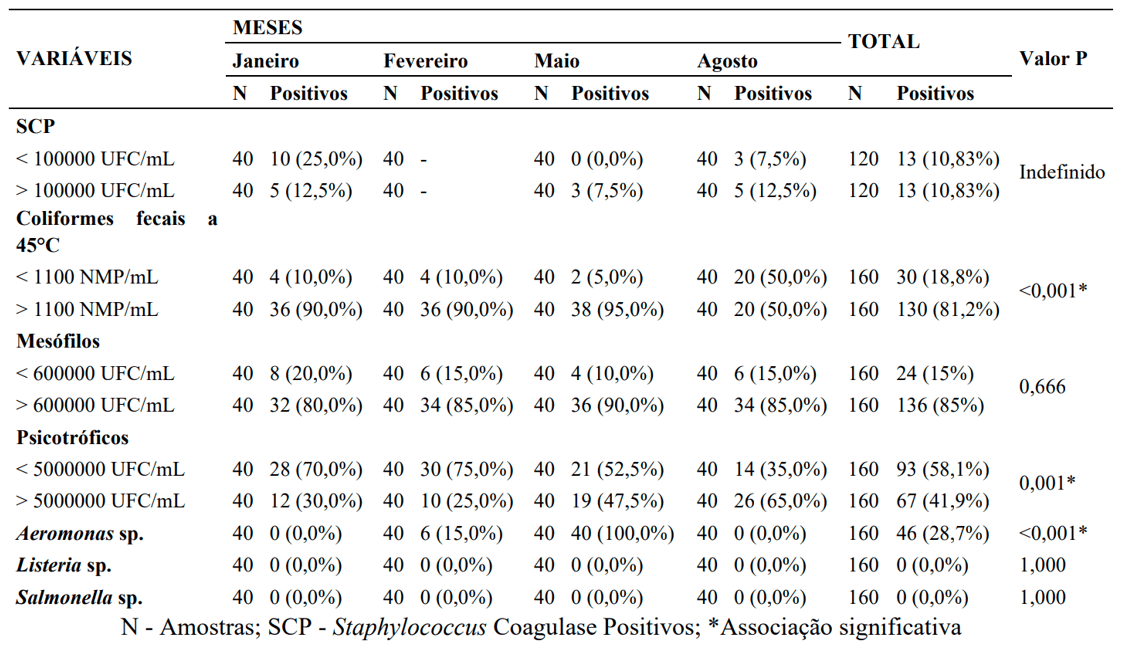
In addition to the storage temperature of milk, time is equally important for compromising quality. According to Luz et al. (2011), the microbiological quality of milk comes from hygiene conditions during milking, cleaning of utensils and equipment before and after pasteurization, as milk provides excellent conditions for the multiplication of microorganisms in a short time.
Being a complete food in nutritional terms, milk serves as a substrate for the development of microorganisms. Thus, the multiplication of psychrotrophic bacteria in milk deteriorates the protein and lipid material even after it has been processed industrially (Maciel; Birkheuer; Rempel, 2018).
Regarding the research on mesophilic microorganisms, 85% (136/160) were outside the limit established at 6×105 CFU/mL (Brazil, 2011), differing from Citadin et al. (2009), who analyzed the microbiological quality of refrigerated raw milk in 31 samples from dairy farms in Paraná and found 25.8% (8/31) outside the established standard.
The milk from tanks with high temperatures found in this study favored the multiplication of mesophilic microorganisms. Amorim et al. (2023), in their study on the physicochemical and microbiological evaluation of UHT cream, also found mesophilic aerobic counts above the standard, characterizing the samples as unsuitable for human consumption.
Therefore, it is necessary to investigate quality, implement necessary corrective actions, evaluate the safety of consumption, and ensure the recall of dairy products that represent a risk or harm to consumer health, since these bacteria signal the presence of pathogens or toxins, promoting food unhealthiness (Brazil, 2022).
However, the microbiota present in milk exhibits great diversification, depending mainly on milking hygiene conditions, utensils and equipment, milk conservation, storage time and temperature, microbiological quality of water, climatic conditions, and mastitis rates (Vallin et al., 2009).
4. CONCLUSION
This study concludes that the high counts of microorganisms in the analyzed milk and the inadequate temperature of the tanks at the time of collection result in obtaining a poor-quality product, due to the deteriorating or pathogenic action of the microorganisms. It is suggested to implement good practices to prevent contamination and microbial growth in the milk production chain to ensure a quality product.
REFERENCES
AMORIM, F. S.; SANTOS, J. L.; CORDEIRO, G. S.; SILVA, D. D.; MOURA, A. P. B. L.; MEDEIROS, E. S.; ROLIM, A. M. Q.; ROLIM, M. B. Q. Avaliação físico-química e microbiológica de cremes de leite UHT comercializados no estado de Pernambuco. Medicina Veterinária, Recife, v.17, n.2(abr-jun), p.134-140, 2023.
BRASIL. Agência Nacional de Vigilância Sanitária. Resolução da Diretoria Colegiada, n o 724, de 1 de julho de 2022. Dispõe sobre os padrões microbiológicos dos alimentos e sua aplicação. Brasília: Diário Oficial da União, 2022.
BRASIL. Ministério da Agricultura, Pecuária e Abastecimento. Instrução normativa nº 76, de 26 de novembro de 2018. Regulamentos Técnicos que fixam a identidade e as características de qualidade que devem apresentar o leite cru refrigerado, o leite pasteurizado e o leite pasteurizado tipo A. Diário Oficial da União, Brasília, 2018.
BRASIL. Ministério da agricultura, pecuária e abastecimento. Instrução normativa nº 62, de 29 de dezembro de 2011. Aprova o regulamento técnico de produção, identidade e qualidade do leite de vaca. Diário Oficial da União, 2011.
BRASIL. Ministério da Agricultura, Pecuária e Abastecimento. Métodos Oficiais para Análises Microbiológicas em Alimentos de Origem Animal e Água. Diário Oficial da República Federativa do Brasil. Brasília, DF, Seção 1, p. 1-2. 18 set. 2003.
CALAHORRANO-MORENO, M. B.; ORDOÑEZ-BAILON, J. J.; BAQUERIZO-CRESPO, R. J. Contaminants in the cow’s milk we consume? Pasteurization and other technologies in the elimination of contaminants. F1000Research, v. 1, jan. 2022.
CANELLAS, A.L.B.; LAPORT, M.S. As múltiplas faces do gênero Aeromonas no contexto da saúde única. Acta Scientiae et Technicae, Vol 9, number 2, 2022.
CERESER, N. D.; ROSSI JÚNIOR, O. D.; MARTINELI, T. M.; SOUZA, V.; RODRIGUES, L. B.; CARDOZO, M. V. Aeromonas no processamento de queijos tipos minas frescal e colonial. Ars veterinaria, Jaboticabal, SP, v.29, n.1, 023-029, 2013.
CITADIN, A. S.; POZZA, M. S. S.; POZZA, P. C.; NUNES, R. V.; BORSATTI, L.; MANGONI, J. Qualidade microbiológica de leite cru refrigerado e fatores associados. Rev. Bras. Saúde Prod. An., v.10, n.1, p.52-59, jan/mar, 2009.
CONCEIÇÃO, R. C. A.; DINIZ FILHO, E. S.; TELES, A. M.; MUNIZ, A. C. S.; VELOSO, T. C. P.; BRITO, R. A.; RODRIGUES, V. C. G.; BEZERRA, D. C.; BEZERRA, N. P. C.; COIMBRA, V. I. C. S. Queijos artesanais em feiras do município de São Luiz-MA. In: CORDEIRO, C. A. M.; BARRETO, N. S. E. Ciência e Tecnologia de Alimentos: o avanço da ciência no Brasil. Editora Científica Digital, vol. 4 -p 205 – 220, Ano 2023.
COSTA, P. D.; DIAS, R. S. Ocorrência de linhagens enterotoxigênicas de Staphylococcus spp. em leite e derivados envolvidos em Doenças Transmitidas por Alimentos. Periódico Científico do núcleo de Biociências, Centro Universitário Metodista Izabela Hendrix. Belo Horizonte, MG, v.03, n.05, ago de 2013.
CRAVEN, H.; MCAULEY, C.; HANNAH, M. Applicability of Enterobacteriaceae and coliforms tests as indicators for Cronobacter in milk powder factory environments. Food Microbiology, v. 94, 103642, abr. 2021.
CRUZ, A. G.; ZACARCHENCO, P. B.; OLIVEIRA, C. A. F.; CORASSIN, C. H. Microbiologia, higiene e controle de qualidade. Coleção lácteos. v. 4, 1 a ed. Rio de Janeiro: Elsevier, 2019.
EMBRAPA GADO DE LEITE. Pecuária de leite espera crescer cerca de 2% em 2020. Embrapa, 2020. Disponível em: https://www.embrapa.br/busca-de-noticias/-/noticia/49358451/pecuaria-de-leite-espera-crescer-cerca-de-2-em-2020. Acesso em: 17 jan. 2024
FREITAS, W. C.; TRAVASSOS, A. E. R.; MACIEL, J. F. Avaliação microbiológica e físicoquímica de leite cru e queijo de coalho produzidos no estado da Paraíba. Revista Brasileira de Produtos Agroindustriais, Campina Grande, v.15, n.1, p.35-42, 2013.
GUIMARÃES, G. M.; MATEUS, L. S.; MORAES, A. I. P.; COSTA, W. S.; SOARES, N. R.; SANTOS, L. S.; SANTOS, P. A. Qualidade do leite in natura perante a instrução normativa IN 76 do Ministério da Agricultura, Pecuária e Abastecimento do Brasil. Research, Society and Development, v. 9, n. 9, e262996746, 2020.
HERVERT, C. J.; ALLES, A. S.; MARTIN, N. H. Evaluation of different methods to detect microbial hygiene indicators relevant in the dairy industry. Milk Quality Improvement Program, Department of Food Science, Cornell University: Ithaca, NY, 2020.
ISO 6579, Microbiology — General guidance on methods for the detection of Salmonella. Fourth edition 15 de Julho 2002.
ISO 688-2. Microbiology of food and animal feeding stuffs — Preparation of test samples, initial suspension and decimal dilutions for microbiological examination — Part 2: Specific rules for the preparation of meat and meat products. (E)2003.
LEIRA, M. H.; BOTELHO, H. A. A.; SANTOS, H. C. A. S. Fatores que alteram a produção e a qualidade do leite: Revisão. PUBVET, v. 12, n. 5, p. 1-13, maio 2018.
LUZ, D. F.; BICALHO, F. A.; OLIVEIRA, M. V. M.; SIMÕES, A. R. P. Avaliação microbiológica em leite pasteurizado e cru refrigerado de produtores da região do Alto Pantanal Sul-Mato-Grossense. Revista Agrarian, v.4, n.14, p. 367-374, 2011.
MACIEL, M. J.; BIRKHEUER, C. F.; REMPEL, C. Qualidade físico-química e microbiológica do leite in natura: revisão sistemática. Natural Resources, v.8, n.1, p.17-30, 2018.
MARTINS, A. G. L. A.; ARAÚJO, C. P. A.; RIBEIRO, C. L. Avaliação da suscetibilidade antimicrobiana de Staphylococcus aureus isolados de leite cru comercializado nas vias públicas do município de Açailândia-MA. In: CORDEIRO, C. A. M.; BARRETO, N. S. E. Ciência e Tecnologia de Alimentos: o avanço da ciência no Brasil. Editora Científica Digital, vol. 4 -p 42 – 53, Ano 2023.
NASCIMENTO, G. R. S.; CRUZ, C. A.; STELLA, A. E.; BARTOLI, R. B. M.; VILELA, G. B.; MENDES, A. C. M. M.; DALL’ACQUA, P. C.; PAULA, E. M. N. Resistência antimicrobiana em Staphylococcus sp. causadores de Mastite Bovina – revisão de literatura. Brazilian Journal of Health Review, Curitiba, v. 6, n. 1, p. 4375-4391, jan./feb., 2023.
OLIVEIRA, F. S. OLIVEIRA, T. F. C.; MORAES, J. F. M. A. Análise microbiológica de leite UHT e leite Pasteurizado comercializados no município de Campinas-SP. J Health Sci Inst., v. 39, n. 2, p. 79- 85, 2020.
ROSA, A. A.; SOARES, J. P. G.; JUNQUEIRA, A. M. R.; ROSA, A. G.; MOREIRA, I. S., MENDONÇA, M. A. Estudo Comparativo da Qualidade Físico-Química e Microbiológica de Leite. PEER REVIEW, Vol. 5, Nº 9, 2023.
SAMPAIO, I. B. M. Estatística aplicada à experimentação animal. Belo Horizonte: Fundação de Ensino e Pesquisa em Medicina Veterinária e Zootecnia, 1998. 221p.
SCHU, K. M.; ZAT, L. H. S. Qualidade microbiológica de leites pasteurizados comercializados em um município do Oeste do Paraná. Revista JRG de Estudos Acadêmicos, Ano 6, Vol. VI, n.13, jul.-dez., 2023.
SILVA, L. G.; LOPES, D. S.; BASTOS, P. A. M. B. Caracterização de bactérias ácido láticas autóctones de Bom Jesus do Itabapoana/RJ: ação antagonista contra Listeria monocytogenes e provas bioquímicas. Vértices (Campos dos Goitacazes), vol. 24, núm. 1, Enero-Abril, 2022.
SILVA, M. R.; SCANAVACCA, J.; GRANDRA, T. K. V.; SEIXAS, F. A. V.; GANDRA, E. A. Avaliação higiênico-sanitária do leite produzido em Umuarama/PR. B.CEPPA, Curitiba, v. 28, n. 2, jul./dez. 2010.
SILVA, N.; JUNQUEIRA, V. C. A.; SILVEIRA, N. F. A. Manual de métodos de análises microbiológicas de alimentos. São Paulo: Livraria Varela, 371 p. 2001.
SILVA, R. T.; LOPES, J. B. A.; OLIVEIRA, K. L. L. Perfil de sensibilidade a antimicrobianos de bactérias patogênicas humanas isoladas de leite cru. Revista do Instituto de Laticínios Cândido Tostes, v. 74, n. 3, p. 185–194, 2019.
VALLIN, M. V.; BELOTI, V.; BATTAGLINI, A. P. P.; TAMANINI, R.; FAGNANI, R.; ANGELA, H. L.; SILVA, L. C. C. Melhoria da qualidade do leite a partir da implantação de boas práticas de higiene na ordenha em 19 municípios de região central do Paraná. Ciências Agrárias. v. 30; n. 1; p. 181-188, 2009.
YAMAGUCHI, M. U; ZANQUETA, E. B.; MOARAIS, J. F; FRAUSTO, H. S. E. G.; SILVÉRIO, K. I. Qualidade Microbiológica de Alimentos e de Ambientes de Trabalho: Pesquisa de Salmonella e Listeria. Revista em Agronegócio e Meio Ambiente, Vol. 6, n. 3, 2013.
[1] PhD in Animal Bioscience. ORCID: https://orcid.org/0000-0003-2473-9451. Currículo Lattes: http://lattes.cnpq.br/5770903127454350.
[2] PhD candidate in Animal Bioscience. ORCID: https://orcid.org/0000-0001-5078-4104. Currículo Lattes: https://lattes.cnpq.br/2775935070259137.
[3] PhD in Agricultural Biotechnology from the Northeast Biotechnology Network (RENORBIO). ORCID: https://orcid.org/0000-0002-7654-5475. Currículo Lattes: http://lattes.cnpq.br/2574390886279350.
[4] Doctor of Veterinary Medicine. ORCID: https://orcid.org/0000-0002-5917-5783. Currículo Lattes: http://lattes.cnpq.br/8326410355923632.
[5] Master of Animal Science. ORCID: https://orcid.org/0000-0002-7067-3855. Currículo Lattes: https://lattes.cnpq.br/7795984886994762.
[6] PhD in Agronomy (Soil Science). ORCID: https://orcid.org/0000-0002-0488-9236. Currículo Lattes: http://lattes.cnpq.br/4666659327763907.
[7] PhD candidate in the Animal Bioscience Graduate Program. ORCID: https://orcid.org/0000-0001-9410-7631. Currículo Lattes: http://lattes.cnpq.br/4532231119888940.
[8] M.Sc. in Animal Bioscience. ORCID: https://orcid.org/0000-0002-4913-8313. Currículo Lattes: http://lattes.cnpq.br/4967459162060058.
[9] Undergraduate student in Bachelor of Biological Sciences. ORCID: https://orcid.org/0000-0001-7149-4931. Currículo Lattes: https://lattes.cnpq.br/2928291078391850.
[10] PhD in Tropical Animal Science. ORCID: https://orcid.org/0000-0001-5405-028X. Currículo Lattes: http://lattes.cnpq.br/8207812492517198.
[11] PhD in Biochemistry and Physiology, Master in Physiology, Biologist. ORCID: https://orcid.org/0000-0003-1493-7964. Currículo Lattes: http://lattes.cnpq.br/9044747136928972.
[12] Advisor. PhD from the Graduate Program in Animal Bioscience. ORCID: https://orcid.org/0000-0002-1289-2902. Currículo Lattes: http://lattes.cnpq.br/5998863169551704.
Material received: September 1, 2023.
Peer-reviewed material approved: October 3, 2023.
Edited material approved by the authors: February 15, 2024.

